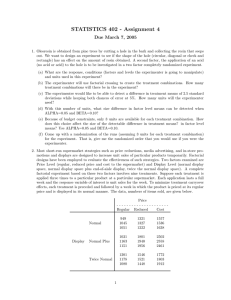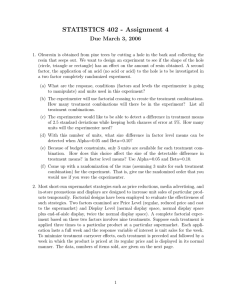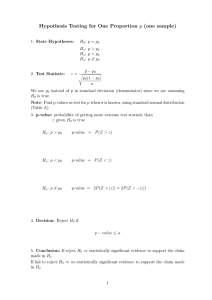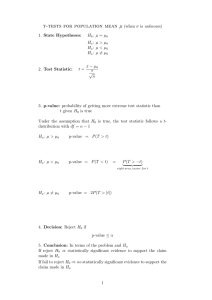STATISTICS 402 - Assignment 4 Due March 4, 2011
advertisement
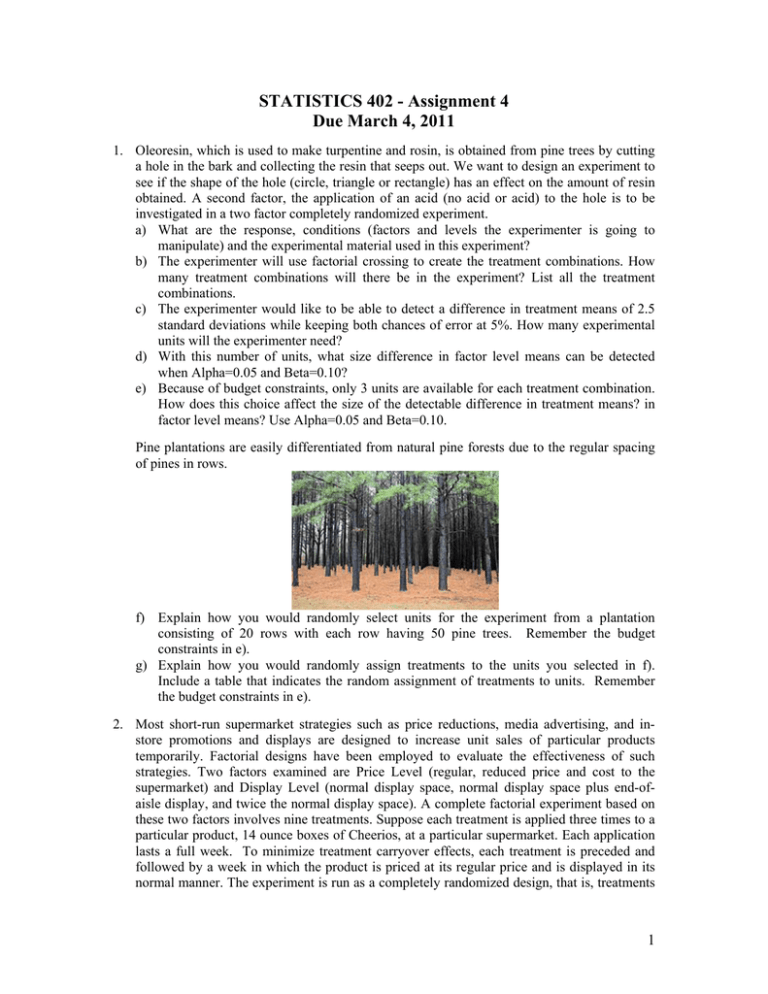
STATISTICS 402 - Assignment 4 Due March 4, 2011 1. Oleoresin, which is used to make turpentine and rosin, is obtained from pine trees by cutting a hole in the bark and collecting the resin that seeps out. We want to design an experiment to see if the shape of the hole (circle, triangle or rectangle) has an effect on the amount of resin obtained. A second factor, the application of an acid (no acid or acid) to the hole is to be investigated in a two factor completely randomized experiment. a) What are the response, conditions (factors and levels the experimenter is going to manipulate) and the experimental material used in this experiment? b) The experimenter will use factorial crossing to create the treatment combinations. How many treatment combinations will there be in the experiment? List all the treatment combinations. c) The experimenter would like to be able to detect a difference in treatment means of 2.5 standard deviations while keeping both chances of error at 5%. How many experimental units will the experimenter need? d) With this number of units, what size difference in factor level means can be detected when Alpha=0.05 and Beta=0.10? e) Because of budget constraints, only 3 units are available for each treatment combination. How does this choice affect the size of the detectable difference in treatment means? in factor level means? Use Alpha=0.05 and Beta=0.10. Pine plantations are easily differentiated from natural pine forests due to the regular spacing of pines in rows. f) Explain how you would randomly select units for the experiment from a plantation consisting of 20 rows with each row having 50 pine trees. Remember the budget constraints in e). g) Explain how you would randomly assign treatments to the units you selected in f). Include a table that indicates the random assignment of treatments to units. Remember the budget constraints in e). 2. Most short-run supermarket strategies such as price reductions, media advertising, and instore promotions and displays are designed to increase unit sales of particular products temporarily. Factorial designs have been employed to evaluate the effectiveness of such strategies. Two factors examined are Price Level (regular, reduced price and cost to the supermarket) and Display Level (normal display space, normal display space plus end-ofaisle display, and twice the normal display space). A complete factorial experiment based on these two factors involves nine treatments. Suppose each treatment is applied three times to a particular product, 14 ounce boxes of Cheerios, at a particular supermarket. Each application lasts a full week. To minimize treatment carryover effects, each treatment is preceded and followed by a week in which the product is priced at its regular price and is displayed in its normal manner. The experiment is run as a completely randomized design, that is, treatments 1 Regular Price Normal Display Normal Display Plus End of Aisle Twice Normal Display 949 1045 1141 1031 1253 1151 1201 1178 1080 Reduced Price 1021 1226 1122 1801 1940 1956 1486 1421 1308 Cost to Supermarket 1557 1506 1668 2102 2188 2031 1772 1803 1912 a) What is the response? What are the conditions? What is the experimental material? b) Why is random assignment of treatments to weeks during the experimental period important for this experiment? Be specific and be sure your answer deals with this experiment. c) Give the full model for these data. Be sure to define all the terms in the model within the context of the problem. d) Are there any treatment effects different from zero? Support your answer with the appropriate statistical test of hypothesis. Be sure to give the null and alternative hypotheses, value of the appropriate test statistic, P-value, decision and reason for the decision and a conclusion in the context of the problem. e) Are there any display effects different from zero? Support your answer with a statistical test of hypothesis. Be sure to give the null and alternative hypotheses, value of the appropriate test statistic, P-value, decision and reason for the decision and a conclusion in the context of the problem. f) Where are the statistically significant differences in display sample means? Support you answer with an appropriate multiple comparison procedure. g) Are there any price level effects different from zero? Support your answer with a statistical test of hypothesis. Be sure to give the null and alternative hypotheses, value of the appropriate test statistic, P-value, decision and reason for the decision and a conclusion in the context of the problem. h) Where are the statistically significant differences in price level sample means? Support you answer with an appropriate multiple comparison procedure. i) Are there any interaction effects that are different from zero? Support your answer with a statistical test of hypothesis. Be sure to give the null and alternative hypotheses, value of the appropriate test statistic, P-value, decision and reason for the decision and a conclusion in the context of the problem. j) Construct an interaction plot. Comment on the plot and what it tells you about the interaction between the two factors. Be specific and be sure your answer deals with this experiment. k) Construct a plot of residuals versus predicted values. Describe the plot and indicate what this tells you about the Fisher conditions necessary for the analysis of variance. l) Construct plots of the distribution of residuals. Describe each of the plots in the distribution of residuals. Indicate what this tells you about the Fisher conditions necessary for the analysis of variance. m) What else does the distribution of residuals tell you about the experiment? Turn in JMP output that you have used to answer the questions. 2
